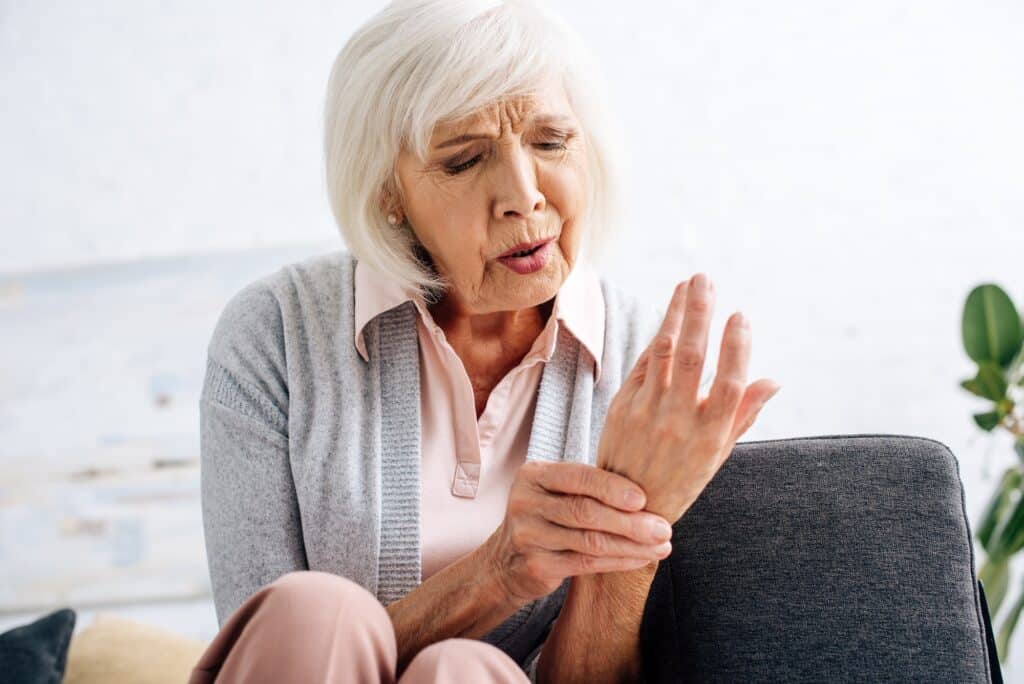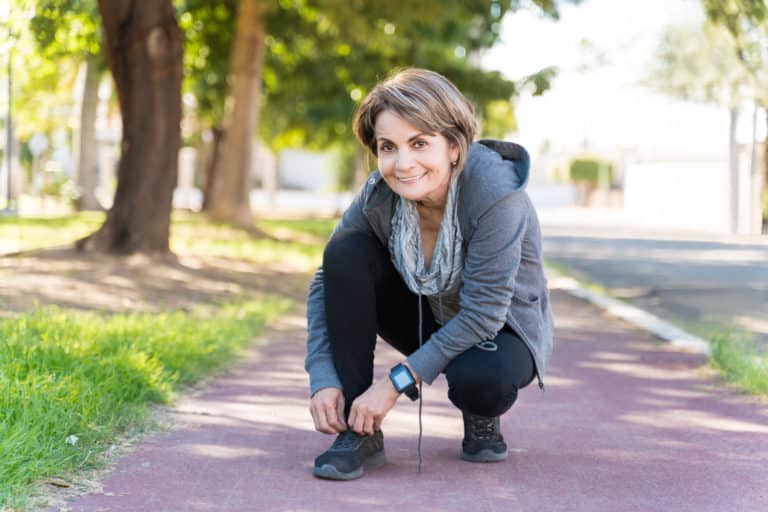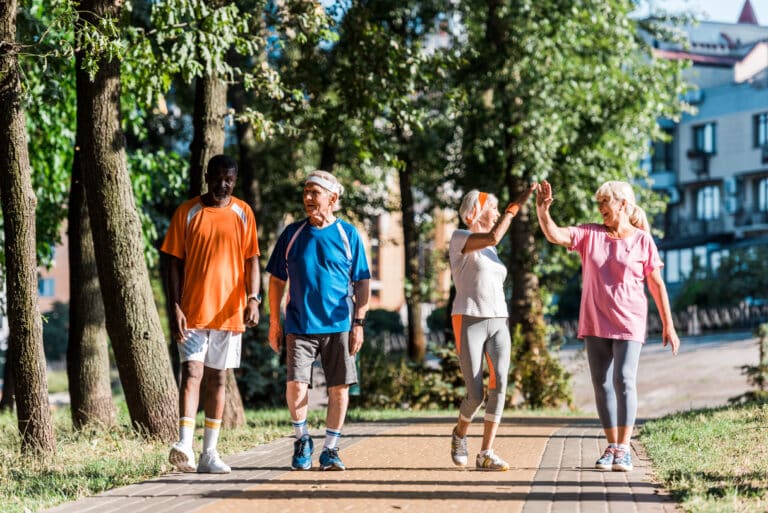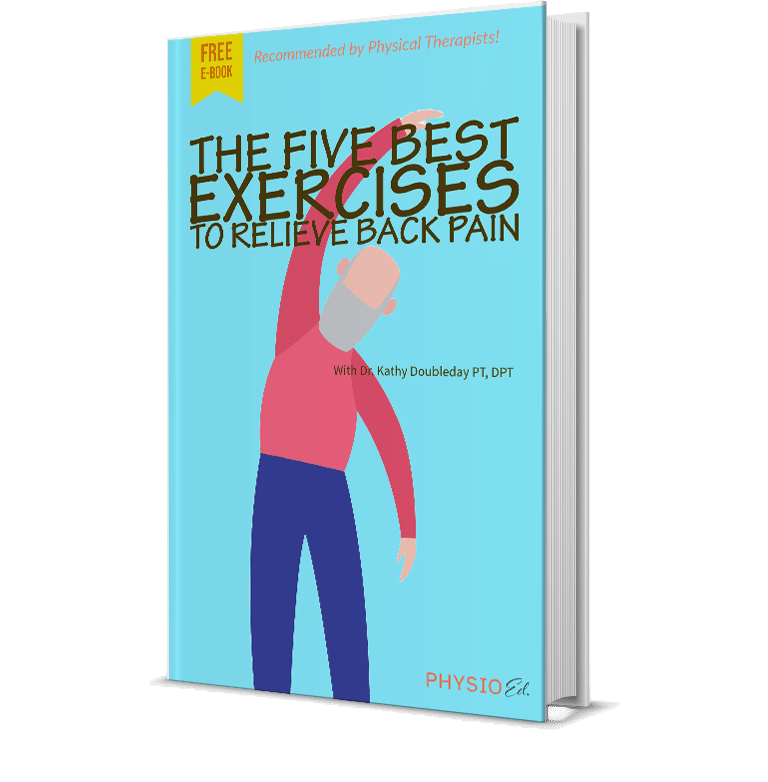Creaky, stiff, or painful joints are all too familiar signs of aging, and arthritis is often the cause. These common symptoms, alongside other signs of aging, can increase the difficulty of performing your daily activities.
Arthritis can result in movement problems and pain. However, it can also be managed with select exercises and proper medical guidance, among other options.
Let’s explore the ins and outs of how to manage arthritis and how to improve your symptoms today.
What is Arthritis?
Arthritis is a common, chronic medical condition that affects millions of people. Arthritis, classified as a joint disorder, often causes pain, stiffness, and inflammation.
Although it is common, arthritis is not a single disease. Rather, it refers to a large group of conditions.
These conditions cause inflammation and tenderness in one or more joints. Arthritis is chronic and can affect any joint in the body, including but not limited to the knees, fingers, and spine.
Types of Arthritis
There are over 100 different types of arthritis, and it is also sometimes broadly known as “inflammatory arthritis.” The most commonly known varieties are osteoarthritis (OA), rheumatoid arthritis (RA), and gout.
Osteoarthritis
Osteoarthritis (OA) is the most common type of arthritis.
OA occurs when the cartilage that typically cushions your joints wears away, causing pain, stiffness, and worsening joint degeneration.
Overuse of a joint and frequent injury increases the likelihood of developing OA. For this reason, osteoarthritis occurs most often in older adults; what doctors commonly call normal “wear-and-tear.”1
Rheumatoid Arthritis
Rheumatoid arthritis (RA) is a systemic autoimmune disorder that affects the lining of the joints. It occurs when the body’s immune system attacks the synovial membrane, a thin layer of tissue that lines the joints.
In severe cases, RA can cause visible deformities. In addition to joint pain and swelling, symptoms may include fatigue, fever, and a feeling of malaise.2
Gout
Gout is arthritis caused by a buildup of uric acid crystals in the joints. This unique pain comes on suddenly and is severe. It most often affects the big toe.
During a gout “attack,” pain and other symptoms can last several days to a few weeks, gradually improving as the attack subsides.
Attacks can become more frequent and severe without adequate disease management. This can lead to long-term damage to those joints.
Psoriatic Arthritis
Psoriatic arthritis occurs in people with psoriasis, a skin condition.
Psoriasis is a chronic autoimmune disease that causes red, itchy, scaly patches on the skin. Psoriatic arthritis causes similar joint symptoms to other arthritis.
Besides joint symptoms, psoriatic arthritis can cause eye redness, nail changes, and stomach issues.
Infectious Arthritis
Infection-related arthritis, such as septic arthritis, results from a bacterial or viral infection.
The infection can travel through the bloodstream to the joints, causing severe inflammation and intense pain, which can result in an infectious arthritis diagnosis.
It’s also worth noting that it’s possible to develop arthritis at any age, made evident by conditions like juvenile rheumatoid arthritis. Joint inflammation and problems with joint function or connective tissues (as in undifferentiated connective tissue disease) may also resemble arthritis.
It’s important to consult with your doctor to have your arthritis appropriately diagnosed.
Risk Factors for Developing Arthritis
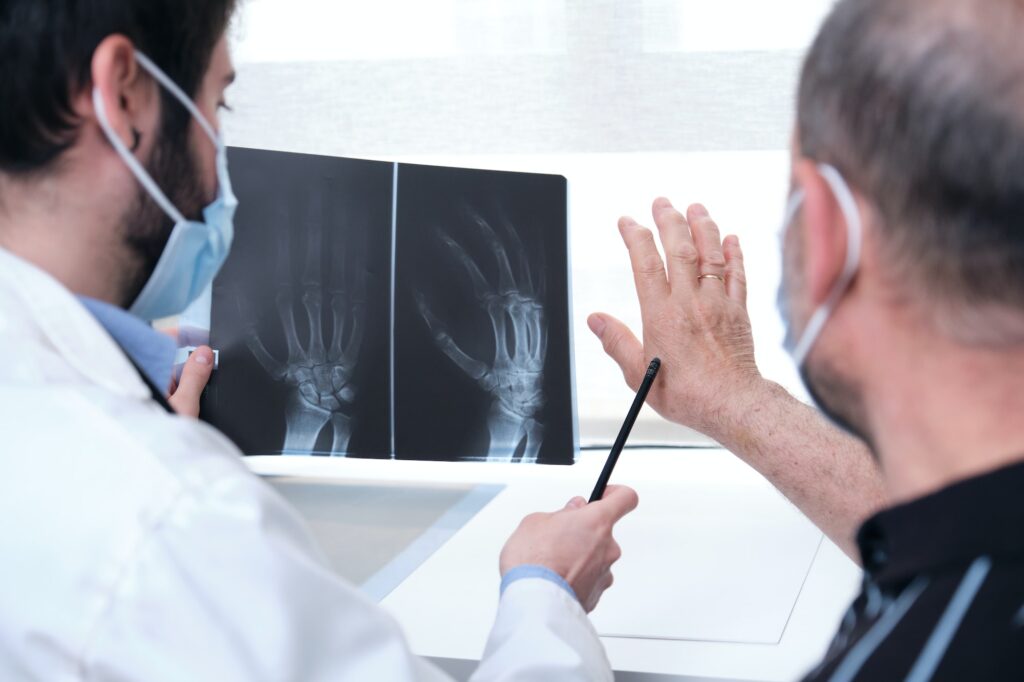
Several factors increase the risk of developing arthritis, including:
- Age — Arthritis is more likely to develop as you get older.
- Sex — Females are more prone to developing arthritis compared to males.
- Obesity — Being overweight may put increased stress on your joints, heightening the risk of arthritis.
- Previous Joint Injuries — A previous injury or repetitive surgery on one joint can increase your risk. For example, multiple knee surgeries at a young age increase your risk of developing arthritis as you age.
- Genetics — A family history of arthritis increases your risk of developing it. Arthritis has a hereditary component, but this depends on the type.
- OA is more often associated with the overuse of a joint than genetics.
- RA, psoriatic arthritis, and ankylosing spondylitis have a more prominent genetic component.
- Research shows that having a close family member with one of these types of arthritis can increase a person’s risk of developing the condition.2
- Lifestyle Choices, Diet, and Environment — Lifestyle factors are also associated with a higher incidence of arthritis for some people. For example, a person who works a heavy manual labor job is at higher risk for developing OA than a project manager on the job site due to the nature of the work.
Common Triggers for Arthritis
One of the critical aspects of managing arthritis is understanding its triggers. These are factors that can exacerbate the symptoms of arthritis, leading to flare-ups.
Common triggers include stress, changes in weather, and physical activity. These can cause increased joint inflammation, leading to heightened pain and stiffness.
Stress
Stress is a prevalent trigger for many people. It can lead to a cascade of physiological responses in the body, including inflammation. Learning stress management techniques, such as deep breathing, meditation, and yoga, can help mitigate this trigger.
Weather
Weather changes, particularly temperature drops or barometric pressure changes, can also increase joint pain and stiffness. While we can’t control the weather, knowing this trigger can help us plan activities and manage symptoms more effectively.
Physical Activity & Lifestyle Considerations
While generally beneficial for overall health, physical activity can sometimes trigger arthritis symptoms. However, this doesn’t mean that physical activity should be avoided.
Instead, it’s about finding the right balance and type of activity that suits your body. Low-impact exercises, such as swimming or cycling, can be excellent choices.
Maintaining a healthy lifestyle is a cornerstone in managing arthritis. This includes a balanced diet, regular exercise, adequate sleep, and avoiding habits such as smoking or excessive alcohol consumption. These lifestyle factors can play a significant role in managing inflammation and, consequently, arthritis symptoms.
Pre-existing Conditions
Managing pre-existing conditions is also crucial. Many people with arthritis may have other health conditions like heart disease or diabetes. These conditions can complicate arthritis management, so working with healthcare providers to manage these effectively is essential.
Regular consultations with healthcare providers are vital. They can provide medical treatments, monitor the progression of the disease, and adjust treatment plans as necessary. They can also offer valuable advice and resources for managing arthritis triggers and improving overall quality of life.
Related Posts
- Printable Lumbar Arthritis Exercises [PDF]
- An Active Adult’s Guide to AC Joint Arthritis
- Rheumatoid Arthritis Self-Care for Older Adults
- Achy Knees: The Facts About Knee Osteoarthritis
- The 5 Best Foot Exercises For Seniors
Symptoms of Arthritis
The symptoms of arthritis will vary depending on the type of arthritis you have. Still, there are some symptoms that all types of arthritis have in common.
Joint pain, stiffness, decreased range of motion, and swelling or redness near the joints are commonly reported for most types of arthritis. Depending on the type of arthritis, some symptoms tend to be more severe than others.
Pain is often one of the first noticed and most limiting symptoms in all kinds of arthritis.
Arthritis can cause pain in any joint affected. The pain can range from mild to severe, gradual to sudden onset. Feelings of worsening pain are typically followed by increased stiffness and swelling.1
The duration of arthritis pain depends on many factors, including which type of arthritis you have and the severity of the case. Sometimes, the pain is temporary and only lasts a few days. Other times, the pain is chronic and can last for several years.
But don’t let that scare you — there are many simple ways to manage arthritis pain.
Treatment Options for Arthritis

Treatment for arthritis will depend on many factors. These include the type of arthritis you have, your comorbidities (other simultaneous conditions), and how exacerbated your symptoms are.
Physical Therapy/Non-Surgical Methods
Targeted exercises may be vital in improving your function and managing arthritis symptoms.
Often, strengthening the muscles surrounding a joint can provide support. Flexibility and range of motion exercises can increase tissue extensibility.
Physical therapy may include heat or cold therapy, soft tissue massage, and dry needling, among other treatment modalities.1
Functional Movement
The term functional movement refers to performing exercises that bolster everyday activities.
Practicing ergonomics (or movement efficiency) can help decrease joint stress by adjusting body posture and adapting movement to suit your lifestyle better.
Our typical movement patterns may often be wearing on a joint due to poor alignment, being overweight, or other factors. Learning to move your body more efficiently can also help reduce pain and prevent further injury.
Exercise
Strengthening exercises can decrease the amount of pressure and stress on a joint.
Increasing the strength of muscles around a joint allows those muscles to take on the impact force instead of the joint structures.
Low-impact exercises such as walking, swimming, and cycling are often recommended for people with arthritis.
Orthotics/Bracing
Wearing custom or even off-the-shelf braces or other supportive devices can help manage pain.
I emphasize to my patients that wearing braces and orthotics is only for support: they can help to decrease pain in the short term, but they are not long-term solutions or substitutes for exercise and proper movement re-education.
Medication
Medications can help with reducing inflammation and pain management. Medications include:
- NSAIDs (nonsteroidal anti-inflammatory drugs).
- Corticosteroids.
- Disease-modifying anti-rheumatic drugs (DMARDs).
Many pain medications, especially among older adults, must be prescribed and taken under the supervision of your physician.3
Surgery
In severe cases of arthritis, getting joint replacement surgery may be necessary to replace the damaged joint with an artificial one.
Often, surgeons will first recommend physical therapy and other conservative management. For some, a total or partial joint replacement may be necessary.
Though not without a tough recovery, these surgeries may improve the quality of movement.
Key Takeaways
- Arthritis is a chronic joint disorder that causes pain, stiffness, and inflammation.
- There are over 100 types of arthritis, including osteoarthritis, rheumatoid arthritis, gout, and psoriatic arthritis.
- The risk factors for arthritis include age, sex, obesity, previous joint injuries, genetics, and lifestyle choices.
- Arthritis symptoms include joint pain, stiffness, decreased range of motion, and inflammation or redness near the joints.
- The treatment options for arthritis include targeted exercises, physical therapy, medications, braces, and surgery.
- There is no cure or reversal for arthritis, but early diagnosis and proper treatment can improve the quality of life.
FAQs
What types of exercises are recommended for seniors with arthritis?
Seniors with arthritis should engage in exercises that foster joint mobility, muscle strength, and cardiovascular health. Stretching routines can enhance flexibility, while weight training builds muscle to support arthritic joints. Aerobic exercises, such as walking, cycling, and swimming, are ideal for improving heart health and maintaining joint function with minimal impact.
How can physical therapy help seniors with arthritis?
Physical therapy aids seniors with arthritis by reducing pain and stiffness, thereby increasing strength and mobility. It plays a crucial role in combating fatigue, preventing further joint damage, and promoting bone health. Additionally, physical therapy can enhance balance and uplift mood, contributing to overall well-being.
What lifestyle changes can seniors with arthritis make for healthier living?
Seniors with arthritis are encouraged to lead a lifestyle incorporating regular exercise, a balanced diet, and maintaining a healthy weight to manage symptoms effectively. It is also advised to avoid excess stress on the joints, quit smoking, and aim for weight loss if necessary, as these steps can positively impact managing arthritis.
What are some physical therapy techniques for seniors with arthritis?
Physical therapy techniques for seniors with arthritis may encompass aquatic exercises that reduce the strain on joints, the use of hot packs to ease muscle tension, and electrical stimulation to manage pain. Engaging with a therapist can lead to a personalized exercise program tailored to individual needs and capacities.
Are there any devices that can help seniors cope with arthritis?
Several assistive devices are available to help seniors manage arthritis more effectively. Canes provide support while walking, grab bars installed in key areas of the home can prevent falls, and tools with larger handles can make everyday tasks less strenuous on the joints. These adaptations help maintain independence and reduce the risk of injury.
Resources:
- Mushtaq, S., Choudhary, R., & Scanzello, C. R. (2011). Non-surgical treatment of osteoarthritis-related pain in the elderly. Current reviews in musculoskeletal medicine, 4(3), 113–122. https://doi.org/10.1007/s12178-011-9084-9
- Ge, X., Frank-Bertoncelj, M., Klein, K., McGovern, A., Kuret, T., Houtman, M., … & Ospelt, C. (2021). Functional genomics atlas of synovial fibroblasts defining rheumatoid arthritis heritability. Genome biology, 22(1), 1-39.
- Fitzcharles, M. A., Lussier, D., & Shir, Y. (2010). Management of chronic arthritis pain in the elderly. Drugs & aging, 27(6), 471–490. https://doi.org/10.2165/11536530-000000000-00000

